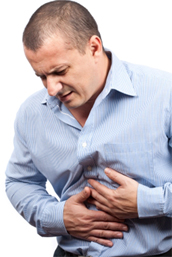Acid Reflux – Causes, Symptoms, Treatments
|
Reading time: 9 minutes
|

Key Takeaways
- Acid reflux occurs when stomach acid flows back into the esophagus, resulting in heartburn.
- Contributing factors include: weak lower esophageal sphincter, certain foods, hiatal hernia, large meals, alcohol, smoking, obesity, pregnancy, medications, and lying down after meals.
- Symptoms commonly experienced include: heartburn, regurgitation, sour taste, nausea, bloating, difficulty swallowing, hiccups, chest pain, asthma, and dental issues .
- Lack of treatment may cause complications, such as the development of ulcers, strictures, or even esophageal cancer.
- Treatment typically involves: implementing lifestyle adjustments, medication management, and regular monitoring by healthcare professionals.
What is Acid Reflux?
Acid reflux, also known as gastroesophageal reflux (GER), occurs when stomach acid flows back up into the tube that connects your mouth to your stomach (esophagus). This acid irritates the lining of the esophagus, causing a burning chest pain called heartburn.
Occasional acid reflux is common and usually isn’t serious. However, if you experience acid reflux more than twice a week, you may have a condition called gastroesophageal reflux disease (GERD). GERD can irritate the lining of your esophagus over time, leading to complications such as ulcers, esophageal strictures, and Barrett’s esophagus.
Common Causes of Acid Reflux
As previously stated, acid reflux occurs when stomach acid flows back up into the esophagus. Several factors can contribute to the development of acid reflux, including:
- Weak lower esophageal sphincter (LES): The LES is a ring of muscle at the bottom of the esophagus that acts like a valve, preventing stomach contents from flowing back up into the esophagus. When this muscle is weak or relaxes abnormally, it allows stomach acid to reflux into the esophagus.
- Eating certain foods: Certain foods can relax the lower esophageal sphincter (LES), the muscular valve between the esophagus and stomach, or irritate the lining of the esophagus, triggering acid reflux. Common culprits include spicy or fatty foods, chocolate, mint, citrus fruits, tomato-based products, garlic, onions, and coffee.
- Hiatal hernia: A hiatal hernia occurs when part of your stomach pushes through the diaphragm into your chest cavity. This can weaken the LES and allow stomach acid to flow back up into the esophagus.
- Eating large meals: Large meals can overwhelm your stomach and cause increased pressure, forcing stomach acid back up into the esophagus.
- Drinking alcohol or carbonated beverages: Alcohol and carbonated beverages can relax the LES and irritate the esophagus, leading to acid reflux.
- Being overweight or obese: Excess weight puts pressure on your abdomen, which can push up your stomach and increase pressure on the LES, worsening acid reflux.
- Pregnancy: Hormonal changes during pregnancy can relax the LES and slow down digestion, contributing to acid reflux.
- Smoking: Smoking weakens the LES and irritates the esophagus, making it more susceptible to acid reflux.
- Certain medications: Some medications, such as nonsteroidal anti-inflammatory drugs (NSAIDs), calcium channel blockers, and certain asthma medications, can relax the LES or irritate the esophagus, contributing to acid reflux.
- Lying down after meals: Gravity helps keep stomach contents in the stomach when you’re standing or sitting upright. Lying down after eating can make it easier for stomach acid to reflux into the esophagus.
Symptoms of Acid Reflux
Acid reflux can present with a variety of symptoms. These symptoms can vary in severity and frequency among individuals. Common symptoms of acid reflux include:
- Heartburn: This is a burning chest pain that usually occurs after eating or lying down. It’s caused by stomach acid irritating the lining of the esophagus.
- Regurgitation (acid reflux): This is the feeling of sour or bitter tasting stomach acid backing up into your throat or mouth.
- Sour taste in your mouth: This unpleasant taste can linger even after the regurgitation subsides.
- Nausea: Acid reflux can cause nausea, which is an uncomfortable feeling of wanting to vomit.
- Bloating: This is a feeling of fullness or tightness in your abdomen.
- Dysphagia: This is the medical term for difficulty swallowing. It can be caused by irritation or inflammation of the esophagus from acid reflux.
- Hiccups: Persistent hiccups can sometimes be a sign of acid reflux.
- Chest pain: Acid reflux can cause a burning pain in the chest that can mimic angina (chest pain caused by heart problems). If you experience chest pain, it’s important to see a doctor to rule out any serious causes.
- Asthma or chronic cough: Acid reflux can irritate the airways, triggering asthma symptoms or a chronic cough.
- Dental problems: Acid reflux can erode tooth enamel, leading to cavities and other dental problems.
Possible Complications of Acid Reflux
Untreated acid reflux can lead to several complications in the esophagus. Esophagitis for example, is the inflammation of the esophageal lining caused by repeated exposure to stomach acid. It can cause symptoms like heartburn, chest pain, and difficulty swallowing. Chronic acid reflux can also erode the lining of the esophagus, forming painful sores called esophageal ulcers.
Over time, scar tissue can develop in the esophagus due to inflammation and ulcers. This scar tissue, also known as esophageal strictures, can narrow the esophagus, making swallowing difficult.
Acid reflux can lead to aspiration, where stomach contents, including acid, are inhaled into the lungs. This can result in respiratory symptoms such as coughing, wheezing, recurrent pneumonia, or worsening of asthma.
Barrett’s esophagus is a precancerous condition that develops in some people with GERD. In Barrett’s esophagus, the cells lining the lower esophagus change to a type of cell that more closely resembles intestinal lining. While rare, Barrett’s esophagus increases the risk of esophageal cancer.
Long-standing GERD and Barrett’s esophagus are risk factors for developing esophageal cancer, although it is relatively rare. Acid reflux can also contribute to other health issues, including laryngitis (inflammation of the voice box), chronic cough, dental problems such as tooth decay, sensitivity or gum disease, and disrupted sleep due to nighttime symptoms.
The Acid Reflux Healing Process
The healing process for acid reflux, also known as gastroesophageal reflux disease (GERD), involves a combination of lifestyle modifications, dietary changes, medications, and sometimes surgical interventions. Here’s an overview of the steps involved in the healing process:
Lifestyle modifications: Making certain lifestyle changes can help alleviate symptoms and promote healing. These changes may include:
- Elevating the head of the bed: Sleeping with the head of the bed raised can help prevent stomach acid from refluxing into the esophagus during the night.
- Avoiding lying down after meals: Waiting at least two to three hours after eating before lying down can reduce the risk of acid reflux.
- Losing weight: If overweight or obese, losing weight can help reduce abdominal pressure and decrease the frequency and severity of reflux episodes.
- Quitting smoking: Smoking can weaken the lower esophageal sphincter (LES) and increase stomach acid production, exacerbating acid reflux symptoms.
- Avoiding tight clothing: Wearing tight belts or clothing around the waist can increase pressure on the stomach and worsen acid reflux.
Dietary changes: Certain foods and beverages can trigger or exacerbate acid reflux symptoms. Avoiding these triggers and adopting a GERD-friendly diet can help promote healing. Dietary recommendations may include:
- Avoiding spicy, acidic, fatty and peppermint-containing foods are common culprits for acid reflux for many people. Pay attention to how your body reacts to certain foods and eliminate or limit those that worsen your reflux.
- Limiting or avoiding caffeine, alcohol, carbonated beverages, and citrus fruits/juices. Chocolate can relax the LES, allowing acid to flow back up. Coffee, while not directly causing acid production, can irritate the esophagus for some people. While some people tolerate citrus fruits and tomatoes well, they can trigger reflux in others. Pay attention to how your body reacts to certain foods and eliminate or limit those that worsen your reflux.
- Eating smaller, more frequent meals rather than large meals. Opting for smaller portions throughout the day instead of cramming large meals into your stomach. This reduces pressure on the LES and lowers the amount of acid your stomach needs to produce.
- Avoiding eating close to bedtime. Eating close to bedtime allows stomach acid to irritate the esophagus while you lie down. Give your stomach at least 2-3 hours to digest before bedtime.
Medications: Over-the-counter and prescription medications may be used to reduce stomach acid production, improve LES function, or protect the esophagus from acid damage. Common medications for acid reflux treatment include:
- Proton pump inhibitors (PPIs): These drugs reduce the production of stomach acid and promote healing of the esophagus.
- H2-receptor antagonists: These medications reduce the production of stomach acid and can provide relief from symptoms.
- Antacids: These drugs neutralize stomach acid and provide temporary relief from heartburn and acid reflux symptoms.
Surgical interventions: In some cases, surgery may be recommended to strengthen the LES or correct structural abnormalities contributing to acid reflux. Surgical procedures for GERD include fundoplication, LINX device implantation, and endoscopic procedures.
Monitoring and follow-up: Regular follow-up with a healthcare provider is essential to monitor symptoms, adjust treatment as needed, and assess healing progress. In some cases, additional testing such as endoscopy or pH monitoring may be recommended to evaluate the extent of esophageal damage and guide treatment decisions.
Additional Tips:
Manage Stress: Stress can worsen acid reflux symptoms. Relaxation techniques like deep breathing and meditation may be helpful.
Consider Chewing Gum: Chewing sugar-free gum after meals can increase saliva production, which helps neutralize stomach acid and wash it down the esophagus.
Most Prescribed Medications for Acid Reflux
The most commonly prescribed medications for acid reflux include:
Proton Pump Inhibitors (PPIs): PPIs are widely prescribed to reduce stomach acid production and promote healing of the esophagus. They are highly effective in providing relief from heartburn and other symptoms of GERD. Some commonly prescribed PPIs include:
- Omeprazole (Prilosec)
- Esomeprazole (Nexium)
- Lansoprazole (Prevacid)
- Pantoprazole (Protonix)
- Rabeprazole (Aciphex)
H2-Receptor Antagonists: H2-receptor antagonists work by blocking the action of histamine, which stimulates acid production in the stomach. While not as potent as PPIs, H2 blockers can provide relief from acid reflux symptoms. Commonly prescribed H2 blockers include:
Prokinetic Agents: Prokinetic agents help improve the motility of the gastrointestinal tract and may be prescribed to strengthen the lower esophageal sphincter (LES) and enhance gastric emptying. However, these medications are less commonly used due to concerns about side effects. One example of a prokinetic agent is metoclopramide (Reglan).
Antacids: Antacids are available over-the-counter and may be prescribed in combination with other medications for short-term relief of heartburn and acid reflux symptoms. They work by neutralizing stomach acid. Common antacid ingredients include calcium carbonate, magnesium hydroxide, and aluminum hydroxide.
Alginate Antacids: Alginate antacids form a protective barrier on top of the stomach contents, helping to prevent reflux into the esophagus. They are often combined with antacids for additional relief. Examples include Gaviscon.
Information provided on this website is for general purposes only. It is not intended to take the place of advice from your practitioner







